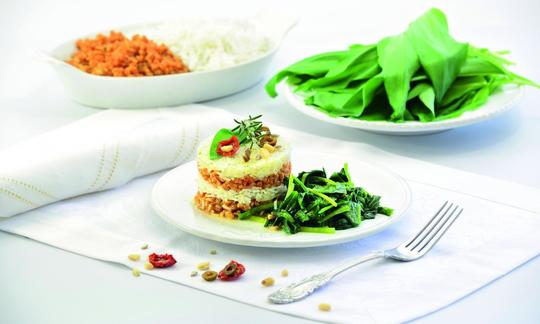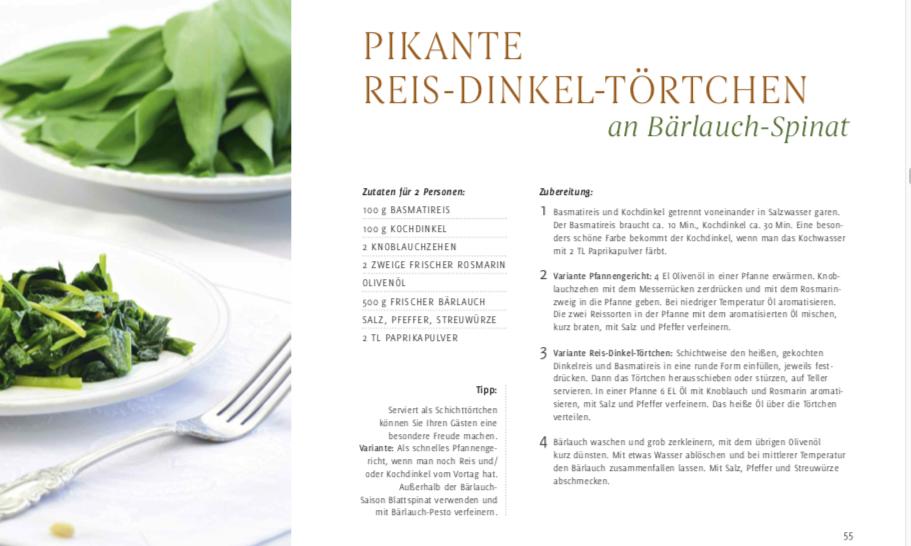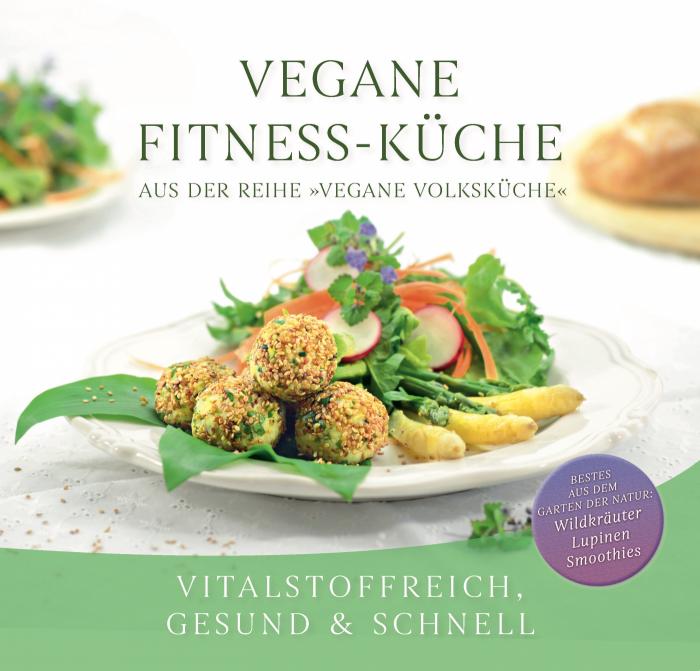Spicy rice-spelt tartlets with wild garlic and spinach
vegan
Ingredients (for servings, )
| 3 ½ oz | Jasmine rice, raw (Thai or Siam rice, perfume rice, fragrant rice) |
| 3 ½ oz | Spelled, raw (husk, fesen, vesen, organic?) |
| 6 tbsp | Olive oil (cold pressed, raw?, organic?) (2.8 oz) |
| 2 cloves | Garlic (organic?) (0.21 oz) |
| 2 sprigs | Rosemary, fresh (0.14 oz) |
| 18 oz | Wild garlic, raw (organic?) |
| 1 dash | Table salt (table salt, raw?, organic?) (0.01 oz) |
| 1 dash | Black pepper (organic?, raw?) (0.00 oz) |
| 2 tsp | Paprika powder, hot (raw?, organic?) (0.16 oz) |
Equipment
- skillet (frying pan)
- stove
- saucepan
Type of preparation
- cook
- fry
- chop or grind
- sauté
- season to taste
- deglaze
Preparation
For the spelt rice
Cook the basmati rice and the spelt separately in salted water. The basmati rice needs about 10 minutes, the spelt about 30 minutes. The spelt gets a particularly beautiful color if you color the cooking water with 2 teaspoons of paprika powder.You can continue with the next steps while the food is cooking.
pan-fried dish variant
Heat 4 tablespoons of olive oil in a pan. Crush the garlic cloves with the back of a knife and add them to the pan with the rosemary sprig. Flavour the oil at a low temperature.
Mix the two types of rice in the pan with the flavored oil, fry briefly and season with salt and pepper.rice-spelt tartlet variant
In a pan, flavor 6 tablespoons of oil with garlic and rosemary and season with salt and pepper.
Pour the hot, cooked spelt rice and basmati rice into a round dish in layers and press each one down firmly.
Then slide the tart out or turn it out and serve on a plate. Spread about 4 tablespoons of the hot oil over the tarts. Put the rest aside.For the wild garlic spinach
Wash the wild garlic and chop it roughly, then sauté it briefly with the remaining olive oil. Deglaze with a little water and let the wild garlic wilt at a medium temperature. Season with salt and pepper.In the original recipe, salt and pepper are also used as seasoning.
Outside the wild garlic season, use leaf spinach and refine it with wild garlic pesto.
|
Nutritional Information per person
Convert per 100g
|
2000 kcal | |
|---|---|---|
| Energy | 781 kcal | 39.0% |
| Fat/Lipids | 43 g | 61.8% |
| Saturated Fats | 6.2 g | 30.8% |
| Carbohydrates (inc.dietary fiber) | 91 g | 33.5% |
| Sugars | 11 g | 12.2% |
| Fiber | 13 g | 50.4% |
| Protein/Albumin | 14 g | 27.4% |
| Cooking Salt (Na:127.4 mg) | 324 mg | 13.5% |
| Essential micronutrients with the highest proportions | per person | 2000 kcal | |
|---|---|---|---|
| Vit | Vitamin C (ascorbic acid) | 376 mg | 470.0% |
| Min | Manganese, Mn | 2.9 mg | 147.0% |
| Min | Iron, Fe | 11 mg | 76.0% |
| Vit | Vitamin A, as RAE | 560 µg | 70.0% |
| Prot | Tryptophan (Trp, W) | 0.16 g | 65.0% |
| Vit | Vitamin E, as a-TEs | 7.6 mg | 63.0% |
| Min | Copper, Cu | 0.60 mg | 60.0% |
| Elem | Potassium, K | 1'170 mg | 59.0% |
| Elem | Phosphorus, P | 396 mg | 57.0% |
| Vit | Vitamin B6 (pyridoxine) | 0.79 mg | 56.0% |
Detailed Nutritional Information per Person for this Recipe
The majority of the nutritional information comes from the USDA (US Department of Agriculture). This means that the information for natural products is often incomplete or only given within broader categories, whereas in most cases products made from these have more complete information displayed.
If we take flaxseed, for example, the important essential amino acid ALA (omega-3) is only included in an overarching category whereas for flaxseed oil ALA is listed specifically. In time, we will be able to change this, but it will require a lot of work. An “i” appears behind ingredients that have been adjusted and an explanation appears when you hover over this symbol.
For Erb Muesli, the original calculations resulted in 48 % of the daily requirement of ALA — but with the correction, we see that the muesli actually covers >100 % of the necessary recommendation for the omega-3 fatty acid ALA. Our goal is to eventually be able to compare the nutritional value of our recipes with those that are used in conventional western lifestyles.
| Essential fatty acids | per person | 2000 kcal |
|---|---|---|
| Linoleic acid; LA; 18:2 omega-6 | 4.7 g | 47.0% |
| Alpha-Linolenic acid; ALA; 18:3 omega-3 | 0.40 g | 20.0% |
| Essential amino acids | per person | 2000 kcal |
|---|---|---|
| Tryptophan (Trp, W) | 0.16 g | 65.0% |
| Threonine (Thr, T, irreversibly transaminated) | 0.42 g | 45.0% |
| Phenylalanine (Phe, F) | 0.67 g | 43.0% |
| Isoleucine (Ile, I) | 0.51 g | 41.0% |
| Valin (Val, V) | 0.65 g | 41.0% |
| Leucine (Leu, L) | 0.95 g | 39.0% |
| Lysine (Lys, K, irreversibly transaminated) | 0.50 g | 27.0% |
| Methionine (Met, M) | 0.25 g | 27.0% |
| Vitamins | per person | 2000 kcal |
|---|---|---|
| Vitamin C (ascorbic acid) | 376 mg | 470.0% |
| Vitamin A, as RAE | 560 µg | 70.0% |
| Vitamin E, as a-TEs | 7.6 mg | 63.0% |
| Vitamin B6 (pyridoxine) | 0.79 mg | 56.0% |
| Vitamin B1 (Thiamine) | 0.56 mg | 51.0% |
| Vitamin B3 (Niacin) | 7.0 mg | 44.0% |
| Vitamin K | 28 µg | 38.0% |
| Vitamin B9, B11 (Folate, as the active form of folic acid) | 72 µg | 36.0% |
| Vitamin B5 (Pantothenic acid) | 1.4 mg | 23.0% |
| Vitamin B2 (Riboflavin) | 0.27 mg | 19.0% |
| Vitamin B7 (Biotin, ex vitamin H) | 2.3 µg | 5.0% |
| Essential macroelements (macronutrients) | per person | 2000 kcal |
|---|---|---|
| Potassium, K | 1'170 mg | 59.0% |
| Phosphorus, P | 396 mg | 57.0% |
| Magnesium, Mg | 142 mg | 38.0% |
| Calcium, Ca | 235 mg | 29.0% |
| Sodium, Na | 127 mg | 16.0% |
| Essential trace elements (micronutrients) | per person | 2000 kcal |
|---|---|---|
| Manganese, Mn | 2.9 mg | 147.0% |
| Iron, Fe | 11 mg | 76.0% |
| Copper, Cu | 0.60 mg | 60.0% |
| Zinc, Zn | 3.0 mg | 30.0% |
| Selenium, Se | 14 µg | 25.0% |
| Fluorine, F | 124 µg | 4.0% |
| Iod, I (Jod, J) | 6.1 µg | 4.0% |
"Vegan Fitness Cuisine - Nutrient-rich, healthy & fast" includes simple, easy-to-prepare German and Mediterranean dishes.
Since this book is written in German, a description is omitted here. If you are interested, please switch to German in the menu.
You can also serve the spicy rice-spelt tarts with wild garlic and spinach as a pan dish.
Nutrient profile: According to GDA guidelines, one portion of this recipe covers several times the average daily requirement of vitamin C and a good 70% of the daily requirement of iron and vitamin A. Due to the amount of olive oil, the dish covers more than 50% of the daily requirement of fat. Since olive oil has a very unfavorable ratio of omega-6 to omega-3 fatty acids, the targeted maximum value of 5:1 is significantly exceeded at 12:1.
Health: For health reasons, we have created an alternative recipe with variations in the ingredients. Please read the link behind this motivation: Vegans often eat unhealthily. Avoidable nutritional errors.
Basmati rice: Basmati rice is a long-grain rice type and is characterized by its loose character and its characteristic aroma, even when uncooked. The basmati grains must be at least 6.5 millimeters long and are narrower in relation to their length than other long-grain varieties.
Spelt: Spelt is a close relative of soft wheat. However, there are differences in the gluten composition. For example, spelt does not contain ω-gliadin, which has been identified as the main trigger for allergic reactions. However, there are only minimal differences between spelt and wheat in terms of the content of fat and fatty acids, amino acids, vitamins and minerals, which probably do not go beyond the natural range of variation. Only the silica content of spelt is significantly higher than that of wheat.
Rosemary: Rosemary leaves have been experimentally proven to have healing effects. Rosemary stimulates circulation, is antiseptic and thus acts as a kind of natural antibiotic, has an antispasmodic effect on the intestines and bile ducts, and relieves pain.
Wild garlic: Wild garlic is very well known as a vegetable, spice and medicinal plant. The entire plant is edible, but the leaves are the ones that are used most often. When the leaves are still small, they are very tender and particularly aromatic. If the wild garlic is in bloom at the time of harvest, the leaves are usually also a little firmer. In spring cooking, it is enjoyed as a soup, in salads, as a vegetable or as a spice. If it is heated, the sulphurous substances change and it loses its special garlic-like taste.
Collecting tips for wild garlic: Wild garlic can be found wild in almost all of Europe and is in season in Switzerland from March to May. It is known that there is a risk of confusion with the extremely poisonous leaves of the lily of the valley, the autumn crocus and the spotted arum. The typical smell that arises when the leaves are rubbed can be used to identify wild garlic. However, this only helps at the beginning, as the smell sticks to your hands. Another option is to look at the leaves. While the autumn crocus and the lily of the valley have several leaves on one stem, wild garlic only has a single leaf per stem.
Quick dish and spinach: As a quick pan dish if you still have rice and/or cooked spelt from the day before. Outside of the wild garlic season, use leaf spinach and refine with wild garlic pesto.
(Gabriele-Verlag)






